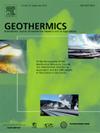Experimental analysis of primary factors controlling carbonate rock dissolution capability and its impact on geothermal reservoir modification
IF 3.5
2区 工程技术
Q3 ENERGY & FUELS
引用次数: 0
Abstract
Carbonate geothermal reservoir is one of the main thermal reservoirs for geothermal resources development and utilization, with abundant thermal resources and good exploitation conditions. The dissolution of carbonate rocks is an important factor in the formation of geothermal reservoirs. In order to explore the control effect of lithology, temperature, and pressure on the dissolution of carbonate rocks, dolomite, limestone, marlstone, and dolomite limestone were used as rock samples. A 0.2 % acetic acid solution was employed for the simulation. A high-temperature and high-pressure solution simulation device was utilized to simulate the dissolution process from surface to deep burial conditions. The results show that: The amount of limestone dissolution follows a “V-shaped” pattern in response to temperature changes and exhibits an “up-down cycle” in response to pressure variations. Furthermore, the impact of temperature on dissolution is significantly greater than that of pressure.The karst erosion and burial depth of different lithologies exhibit a trend of "initial increase followed by decrease," existing a "peak of dissolution". The dissolution peak of dolomite occurs at approximately 4500 m, while that of limestone exceeds 6500 m. The dissolution capacity of mudstone is relatively low, reaching its maximum around 4000 m. Consequently, three potential stages for the formation of high-quality heat storage can be delineated as shallow to moderately buried limestone, moderately to deeply buried dolomite limestone, and deeply buried dolomite.Simultaneously, the “selective” mechanism of dissolution of carbonate rocks is examined, encompassing both the “composition selective” dissolution of calcite during the dissolution process and the “structure selective” dissolution occurring within fissures, particle edges, and crystal surfaces.
碳酸盐岩溶蚀能力主要控制因素及其对地热储层改造影响的实验分析
碳酸盐岩地热储层是地热资源开发利用的主要热储层之一,热资源丰富,开发条件好。碳酸盐岩的溶蚀作用是地热储层形成的重要因素。为探索岩性、温度、压力对碳酸盐岩溶蚀作用的控制作用,以白云岩、灰岩、泥灰岩、白云岩灰岩为岩样。采用0.2%醋酸溶液进行模拟。利用高温高压溶液模拟装置模拟了从地表到深埋的溶蚀过程。结果表明:石灰石溶解量随温度变化呈“v”型,随压力变化呈“上下循环”。此外,温度对溶解的影响明显大于压力。不同岩性的岩溶侵蚀和埋藏深度呈现“先增大后减小”的趋势,存在“溶蚀峰值”。白云岩溶蚀峰出现在约4500 m,石灰岩溶蚀峰超过6500 m。泥岩溶蚀能力相对较低,在4000 m左右溶蚀能力最大。因此,高质量储热形成的三个潜在阶段可以划分为浅埋—中埋灰岩、中埋—深埋白云岩灰岩和深埋白云岩。同时,研究了碳酸盐岩溶蚀的“选择性”机制,包括溶蚀过程中方解石的“成分选择性”溶蚀和裂隙、颗粒边缘和晶体表面中发生的“结构选择性”溶蚀。
本文章由计算机程序翻译,如有差异,请以英文原文为准。
求助全文
约1分钟内获得全文
求助全文
来源期刊

Geothermics
工程技术-地球科学综合
CiteScore
7.70
自引率
15.40%
发文量
237
审稿时长
4.5 months
期刊介绍:
Geothermics is an international journal devoted to the research and development of geothermal energy. The International Board of Editors of Geothermics, which comprises specialists in the various aspects of geothermal resources, exploration and development, guarantees the balanced, comprehensive view of scientific and technological developments in this promising energy field.
It promulgates the state of the art and science of geothermal energy, its exploration and exploitation through a regular exchange of information from all parts of the world. The journal publishes articles dealing with the theory, exploration techniques and all aspects of the utilization of geothermal resources. Geothermics serves as the scientific house, or exchange medium, through which the growing community of geothermal specialists can provide and receive information.
 求助内容:
求助内容: 应助结果提醒方式:
应助结果提醒方式:


